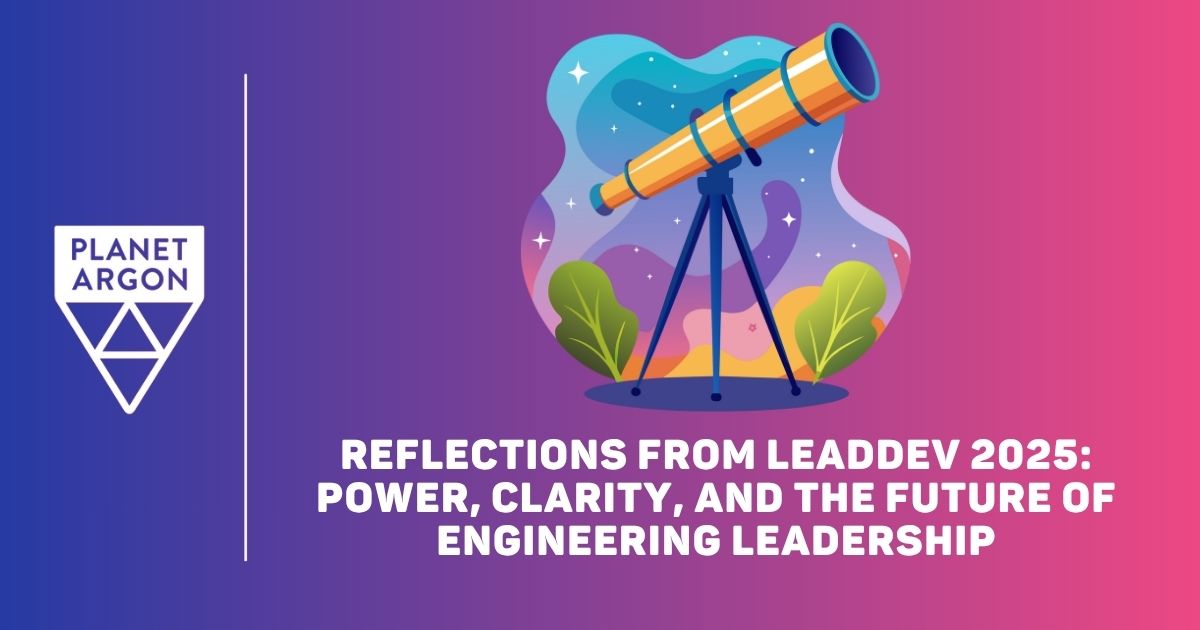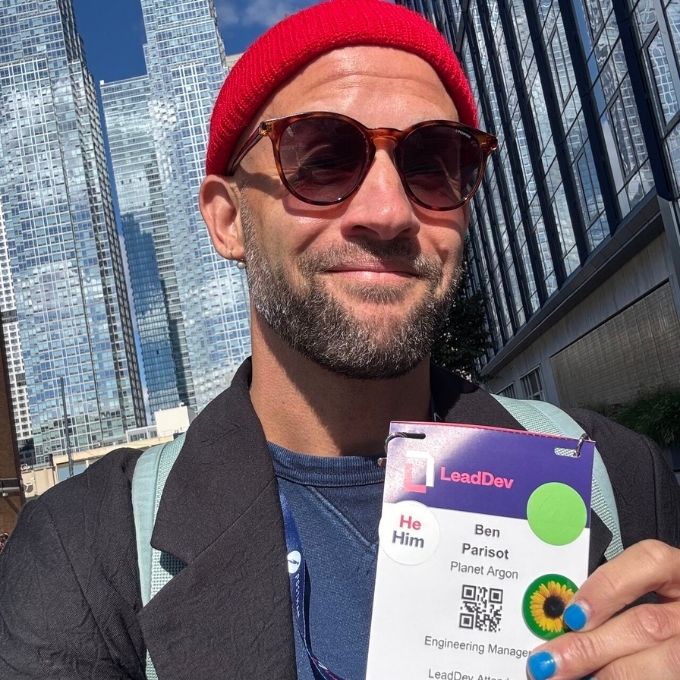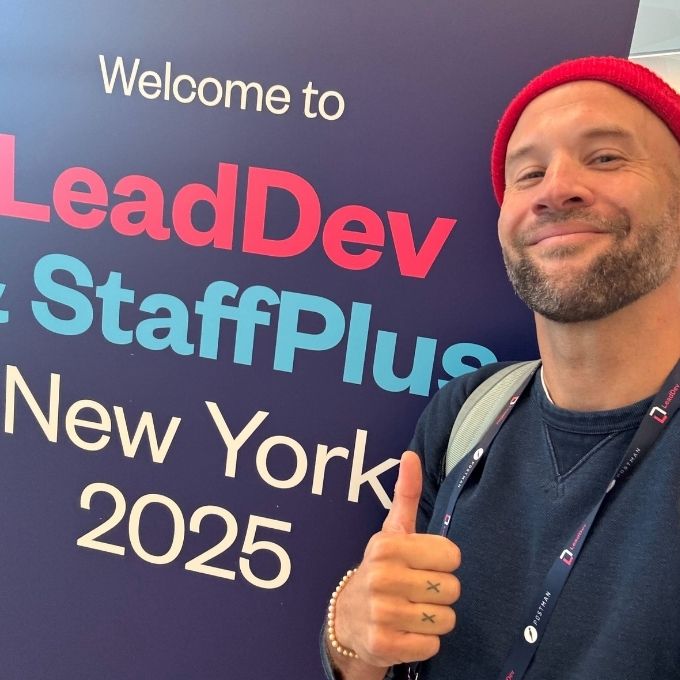Reflections from LeadDev 2025: Power, Clarity, and the Future of Engineering Leadership
Reading time: ~ 6 minutes

Last month I attended LeadDev 2025, and like previous years it delivered exactly what I’ve come to love about this conference: thought-provoking talks, great networking opportunities, and the space to connect with other managers over some of the common challenges of leading engineering teams.

What makes LeadDev special isn’t just the caliber of the talks (though they are indeed high-caliber!), it’s that the speakers and hosts shed the cynicism that too often hangs over our industry and instead talk sincerely about what it means to lead teams well. The two days were full of insight, but also full of honesty, vulnerability, and humor. It was a much-needed reminder that none of us have it all figured out, and that’s okay.
MC David Yee set that tone from the start:
You are not way behind. The things you find hard and confusing — others find them hard and confusing too.”
By the end, his closing message tied the whole event together:
Even if you don’t have the autonomy you used to, you have more real power than you know. So, use your political capital, use your power, to help your teams survive. Use your power to help each other survive.”
That line idea ran through much of what I took away from this year’s LeadDev: leadership isn’t about control; it’s about clarity, stability, and shared power.
Power and Responsibility
My favorite talk of the conference was Anil Dash’s keynote on how power actually moves through organizations. His point was simple but profound: systems run on power, and the purpose of a system is what it does. If we don’t like the outcomes of the systems we’re in, it’s not necessarily that they’re broken — they just might not be designed to produce the outcomes we want.
Dash reframed the old “ladder” metaphor of advancement as a wheel — power isn’t hierarchical, it’s circular. Everyone in an organization both gives and receives power. That idea connected beautifully with Denise Yu’s talk on leading sustainably when everything feels like it’s on fire. She reminded me that as a middle manager, my job is to understand the system, not reject it. Politics happen with or without us, and the trick is to engage with them ethically and strategically without losing our values.
Both talks emphasized something I think a lot of engineering managers feel right now: we’re in the middle of everything. We don’t always get to decide what happens, but we do decide how we use our influence, how we spend our political capital, and how we help our teams see clearly when the rest of the organization feels chaotic.
AI as a Mirror, Not a Replacement
Another thread that ran through nearly every technical talk was (surprise!) AI. Not as hype, but as a mirror. Addy Osmani, Bill Harding, Angie Jones, and others all touched on how AI is reshaping engineering culture, productivity, and even our sense of craftsmanship.
Osmani described context engineering as the new core skill: your AI output is only as good as your inputs, your clarity, and your understanding of what you’re actually trying to build. Harding brought hard data that cut through the hype we’ve all been inundated with over the past few years. (Yes, developer velocity has gone up, but code review time and maintenance costs have gone up too. Oops!) Jones reframed AI adoption as a change management problem: you can’t mandate it, you have to model it.
The through-line: AI doesn’t fix bad processes — it amplifies them.
If it’s boring, automate it. If it’s critical, humanize it.”
That’s a mantra I brought home with me and am trying to internalize as we wrap up the year at Planet Argon and look forward to new projects and engineering team goals in 2026.
Predictability Over Speed
One of the talks that hit closest to home for me was Chris Bigelow’s “Predictable Is Better Than Fast.” He argued that unpredictability — whether from rushing code out the door or being too obsessed with details — creates chaos that ripples through an organization. In his words, this is the butterfly effect of delivery speed.
That idea tied back well to Jason Lengstorf’s (shout-out fellow Portlander!) earlier session on the discipline of not touching things. Great leaders, he said, create clarity and confidence, not chaos. They resist the urge to change things constantly and give their teams uninterrupted space to execute.
Together, these ideas reinforce something that myself and our PM team at Planet Argon have been trying to make space for: long focus cycles, fewer interruptions, and trust in the process. Predictability doesn’t mean stagnation. It’s actually what creates room for creative risk-taking.
Growth and Conflict as Leadership Skills
Two of the most practical talks came from Kelly Vaughn and Liz Hustedt, who tackled team growth and team member conflict head-on.
Vaughn’s framework for recognizing different types of performers (Superstars, Rockstars, etc.) was a good reminder that not everyone wants a promotion, but everyone deserves growth. That could mean more visibility, or it could mean more stability — the key is knowing which is which.
Hustedt followed with “Paying Your Conflict Debt,” which defined conflict not as emotion but as opposing needs and priorities. Avoiding conflict, she argued, doesn’t protect your culture, but instead corrodes it. Her framing of nonviolent communication as clarity without cruelty was powerful. It’s a skill every leader should practice through blameless retrospectives or performance conversations.
The Human Side of Leadership
George Mandis’s talk on morale during uncertain times was one of those quiet, grounding sessions that reminded me why I love this community. His message: honesty is more inspiring than aspiration.
Similarly, Lengstorf’s talk (which opened the conference) started as a story about misunderstanding leadership and ended with a philosophy I’ll be thinking about for a long time:
A leader’s job is not to have ideas. It’s to create space and boundaries so the team can have them.”
These two talks shared the theme that leadership is about cultivating the conditions for people to do their best work, not doing the work for them, absorbing their stress, or helicopter-parenting their process. Stability, clarity, and trust are the real deliverables of a manager.
What I’m Bringing Back to My Team
Conferences are great, but only if the ideas come home with you. Here are a few I’m planning to put into practice at Planet Argon:
Give teams longer, uninterrupted focus windows. This could look like longer sprint windows, not spreading engineers’ hours over too many client projects at once, and protecting their calendar to allow for deep focus. As we approach the new year, I’ll be talking with engineers and working with the PM team to find approaches that work best for individuals’ schedules and preferred workflows without sacrificing delivery speed or code quality.
Treat documentation as architecture. I have to admit that I’ve always thought of documentation as something you develop as you go (the ideal) or (most often) when you’re finished with the work. This conference got me to shift my way of thinking about documentation from an addendum to a planning document. I’m not sure how we’ll work this into our current workflows, but I’m excited to brainstorm the idea with the team.
Experiment with AI-assisted workflows, but pair them with human-reviewed safety nets. Everyone on our team is using AI-assistants in some way, and we have best practices in place to protect our clients’ data and application security. However, we’re currently taking a bit of a scattershot approach to controlling for quality with AI-generated or -assisted code, mostly because it’s harder to track. I left LeadDev this year with a number of great ideas on how to put some guardrails around AI-assisted code generation without discouraging the team from using the latest tools to improve their workflows.
Automate the boring stuff so humans can focus on creativity and verification. This is related to AI-guardrails, but not the same thing exactly. While guardrails are meant to prevent repo bloat and provide transparency around what kind of AI-assisted contributions are being added to an application, this idea focuses more on identifying workflows and processes that are candidates for automation, either in a client project or on our internal team.
Practice nonviolent communication and emphasize clarity without cruelty. I’ve always thought of myself as a proactive and empathetic manager, and in a lot of ways I still think that’s true. However, this year’s LeadDev showed me that there are actual frameworks I can use to not only resolve conflict but encourage empathy and problem-solving practices in others. I’m excited to dive deeper into the nonviolent communication practice and apply my learnings to our team culture.
For onboarding devs, make their first PR a demonstration of understanding the codebase. This is something we kinda sorta already do (usually, “resolve this bug”, or “update this documentation”), but I intend to formalize it more so engineers joining the team or being newly added to a project have clear expectations around their first PR. We’ll be discussing this in an upcoming all-hands engineering team meeting and brainstorming ways “demonstrating understanding” can show up in a PR.

Final Reflection: We Are the Industry
The message that echoed through so much of this conference was this: we are the industry. Not big tech CEOs, pundits, or LinkedIn influencers chasing clout. While we may not be the loudest or flashiest, the industry is actually made up of the people building teams, shipping code, maintaining systems, and keeping engineers (e.g., humans) connected and sane amongst all the hype and noise.
This year’s LeadDev didn’t just talk about AI or processes or management frameworks. It reminded me that leadership, at its core, is a deeply human act, and one that depends on clarity, empathy, and courage. I left the conference feeling more connected to my peers and inspired by my colleagues, and I’m excited to explore these bigger themes and new process improvements with my team in the months ahead!